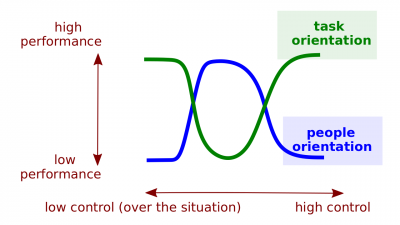Difference between revisions of "Fiedler contingency model"
| Line 1: | Line 1: | ||
| − | |||
| − | |||
| − | |||
[[File:Fiedler-contingency.png|400px|thumb|right|[[Fiedler contingency model]]]][[Fiedler contingency model]] (hereinafter, the ''Model'') is a model that suggests that effective group performance depends on the proper match between a leader's orientation, whether he or she is [[task orientation|task-oriented]] or [[Human relations orientation|people-oriented]], and the degree to which the situation allows the leader to control and influence. The ''model'' (1) uses a [[least preferred coworker questionnaire]] to classify leaders, (2) assumes that leaders cannot be both [[task orientation|task-oriented]] or [[Human relations orientation|people-oriented]], and (3) suggests that [[Human relations orientation|people orientation]] is the best match to the situations with moderate control, while those leaders who are [[task orientation|task-oriented]] best perform in situations with high or low control. | [[File:Fiedler-contingency.png|400px|thumb|right|[[Fiedler contingency model]]]][[Fiedler contingency model]] (hereinafter, the ''Model'') is a model that suggests that effective group performance depends on the proper match between a leader's orientation, whether he or she is [[task orientation|task-oriented]] or [[Human relations orientation|people-oriented]], and the degree to which the situation allows the leader to control and influence. The ''model'' (1) uses a [[least preferred coworker questionnaire]] to classify leaders, (2) assumes that leaders cannot be both [[task orientation|task-oriented]] or [[Human relations orientation|people-oriented]], and (3) suggests that [[Human relations orientation|people orientation]] is the best match to the situations with moderate control, while those leaders who are [[task orientation|task-oriented]] best perform in situations with high or low control. | ||
Revision as of 10:19, 20 November 2018
Fiedler contingency model (hereinafter, the Model) is a model that suggests that effective group performance depends on the proper match between a leader's orientation, whether he or she is task-oriented or people-oriented, and the degree to which the situation allows the leader to control and influence. The model (1) uses a least preferred coworker questionnaire to classify leaders, (2) assumes that leaders cannot be both task-oriented or people-oriented, and (3) suggests that people orientation is the best match to the situations with moderate control, while those leaders who are task-oriented best perform in situations with high or low control.
- Least preferred coworker questionnaire. An instrument that purports to measure whether a person is task or relationship oriented. The questionnaire has initially been developed for the Fiedler contingency model.
